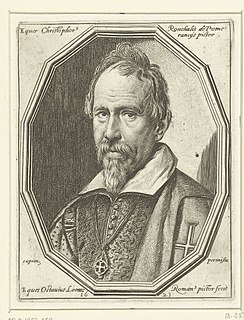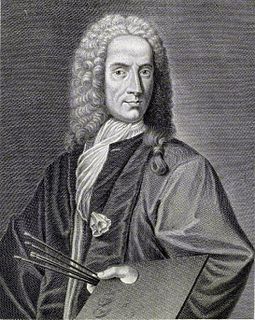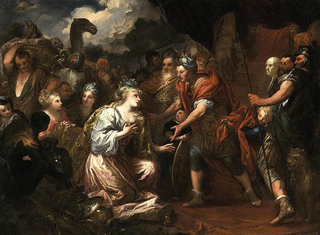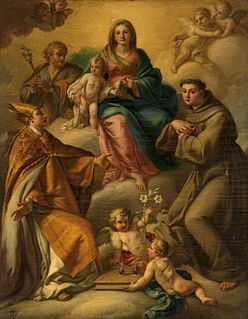Related Research Articles

Belisario Corenzio was a Greek-Italian painter, active in Venice and Naples. He is one of few Greek painters that did not belong to the Cretan Renaissance like his contemporaries of the time. He escaped the maniera greca completely. He adopted the Venetian style. Other similar Greek painters were Marco Basaiti, Ioannis Permeniates, Antonio Vassilacchi and El Greco. He was sometimes referred to as Il Greco. His teacher was prominent Venetian painter Tintoretto. In 1590, at age 32 Corenzio settled in Naples. Corenzio was influenced by Cavalier d'Arpino. He continued to flourish in the region. His apprentices included: Luigi Rodriguez, Andrea di Leone, Onofrio De Lione and Massimo Stanzione. Corenzio painted many frescos that survived today. Some of his works are in the Church of San Severino and Certosa di San Martino. His style resembles Caravaggio. An Italian legend in Naples exists involving Corenzio, Spanish painter Jusepe de Ribera, and Battistello Caracciolo. They were referred to as the Cabal of Naples. The three painters were rumored to have poisoned their competition for painting contracts. The rumors lack documented evidence. The three painters were very popular in Naples. Corenzio frescoed the Crypt that holds the remains of Matthew the Apostle at Salerno Cathedral and it depicts scenes from the Gospel of Matthew. Corenzio was one of the most celebrated fresco painters in Naples during his time. His drawings can be found all over the world namely at the Metropolitan Museum, Museo di Capodimonte and Louvre.

Corrado Giaquinto was an Italian Rococo painter.

Chiaia is an affluent neighbourhood on the seafront in Naples, Italy, bounded by Piazza Vittoria on the east and Mergellina on the west. Chiaia is one of the wealthiest districts in Naples, on the main streets of Chiaia many luxury brands have their shops. In the central area there are also important schools and high schools.

Cristoforo Roncalli was an Italian mannerist painter. He was one of the three painters known as Pomarancio or Il Pomarancio.

Marcello Venusti was an Italian Mannerist painter active in Rome in the mid-16th century.
Giovanni Gioseffo dal Sole was an Italian painter and engraver from Bologna, active in the late-Baroque period. Upon the death of Carlo Cignani, Gioseffo dal Sole became among the most prominent painters in Bologna, described as the Guido Moderno.

Guglielmo Borremans or Guglielmo Fiamingo (1670–1744) was a Flemish painter whose documented career took principally place in Italy, in particular Naples, Cosenza and Sicily. Here he was one of the pre-eminent late-Baroque fresco painters of the first half of the 17th century who received multiple commissions to decorate churches and palaces.

Antonio Zanchi was an Italian painter of the Baroque, active mainly in Venice, but his prolific works can also be seen in Padova, Treviso, Rovigo, Verona, Vicenza, Loreto, Brescia, Milano, and Bergamo, as well as Bavaria.
Lazzaro Calvi (1512–1587) was an Italian painter of the late-Renaissance period. He was born in Genoa and trained with his father Agostino Calvi and Perin del Vaga. Older sources claim he lived till the improbable age of 105 years

Luigi Garzi was an Italian painter of the Baroque period, whose work displayed heavy influences of the Bolognese painter, Guido Reni.

Giuseppe Nicola Nasini was an Italian painter of the Baroque period, active in Rome and Tuscany.

Carlo Giuseppe Ratti (1737–1795) was an Italian art biographer and painter of the late-Baroque period. He was a pupil of the painter Giovanni Agostino Ratti. Born in Savona, he moved to Rome where he befriended Anton Raphael Mengs and Pompeo Batoni. He died in Genoa, where he labored for many years.

Pietro Dandini was an Italian painter of the Baroque period, active mainly in Florence.

Astolfo Petrazzi was an Italian painter of the Baroque period, active mainly in his hometown of Siena, but also Spoleto and Rome. He was a pupil of mainly Francesco Vanni, but also worked under Ventura Salimbeni and Pietro Sorri. He died in Siena.

Giuseppe Tortelli was an Italian painter of the late-Baroque period, active in Brescia.
Arcangelo Guglielmelli was an Italian architect and painter, active in his native Naples, Italy, in a late-Baroque style. He was involved in the building and reconstruction of churches, many of which had been damaged by the earthquakes of 1688 and 1694.

Fedele Fischetti was an Italian painter of the Neoclassical period. He was born and died in Naples.
Giovanni Sarnelli was an Italian painter of the late-Baroque style. He was one of at least four brothers: including Antonio, Gennaro, and Giuseppe, trained in the studio of Paolo de Matteis, and active painting mainly sacred subjects in Campania, Italy. Their father had been an army officer for the Royal administration. One of Giovanni's brothers, Ferdinando, was a secretary of the Banco di San Giacomo. The biographer Bernardo De Dominici mainly recalled Gennaro, but mentioned that Antonio and Giovanni, then still alive were excellent pupils of Matteis.
Bartolomeo Passante or Bassante was an Italian painter of the Baroque era active in Naples.

Andrea Carrera or Carreca was an Italian Baroque painter mainly active in Sicily. He was born in Trapani and died in Palermo.
References
- ↑ Repubblica, article titled A Palazzo Zevallos: Santa Caterina il capolavoro “ritrovato” del Barocco, March 5, 2016.